| Page last updated
25 August 2006 |
MUSSELp Collecting Sites in the Republic of Congo, 2006
From 25 July to 19 August 2006, the MUSSELp participated in a sampling expedition to Malebo Pool and the Lower Congo in the Republic of Congo. Mollusks and other invertebrates were collected at 14 sites; below, we report only upon the sites that yielded freshwater mussels. Locality notes are transcribed from our field note book.
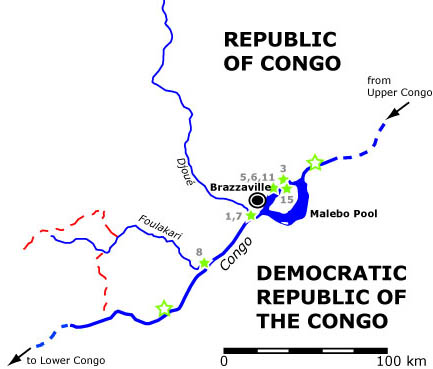 The map to the right shows the geographical extent of our aquatic sampling of the Lower Congo in the Republic of Congo. Sites where freshwater mussels were collected are marked with green stars, and the highest and lowest sampling points (neither of which yielded mussels) are marked with open stars. Numbers in gray refer to our site numbers. The map to the right shows the geographical extent of our aquatic sampling of the Lower Congo in the Republic of Congo. Sites where freshwater mussels were collected are marked with green stars, and the highest and lowest sampling points (neither of which yielded mussels) are marked with open stars. Numbers in gray refer to our site numbers.
For each site, geocodes were determined by handheld GPS. Geocode links map the points with Google Maps.
To summarize the results of our survey, the Congo River below Malebo Pool is characterized by steep sandstone banks of either bedrock or boulders. In the Lower Congo, the substrate is sand, and river is divided into a series of enormous pools and rapids. The Lower Congo, based upon our own collections and museum work, seems to be a barrier to freshwater mussels (and mollusks generally), perhaps as far down as Matadi, DRC. The only species that we found in the Lower Congo was Etheria elliptica; none live.
Malebo Pool, in contrast, was excellent mussel habitat. The Pool is dotted by a number of sand islands, and on these are backwaters with substrates of soft mud. The mussels were suspended in this soft mud and could generally be collected by pollywogging. We collected six species in the pool.
 MPC-2006-003 MPC-2006-003
Congo River, Malebo Pool, 1 km below the mouth of the Loufoula, Republic of Congo.
-04.109°, 015.415°
29 July 2006; KSC & DLG!
Braided channel, about 50 m wide. Shallow black-water; sandy-silty-muddy. Firm with patches of vegetation.
Lots of big, fat, like ampularids. One Coelatura sp. |
MPC-2006-006
Congo River, Malebo Pool, near side of sand island, Kintele, Republic of Congo.
-04.156°, 015.357°
30 July 2006; KSC & DLG!
After much sampling in what we thought was suitable mussel habitat, we found some dead shells in mud. This was basically a dead-end spring that dried up before it reached the main river.
The live mussels were found in [soft-mud] with vegetation; water about 0.5 m deep. Water nice and cool (cooler than expected).
Species: Mutela cf. rostrata, Coelatura gabonensis.
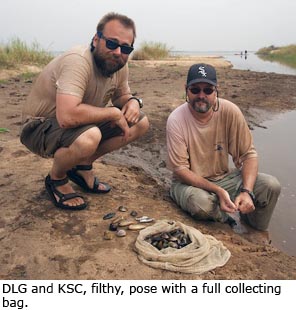 MPC-2006-005 MPC-2006-005
Congo River, Malebo Pool, far side of sand island, Kintele, Republic of Congo.
-04.165°, 015.359°
30 July & 12 August 2006; KSC, DLG, Stiassny et al.!
While we were up to our knees in [soft-mud], the Fish Crew was fishing on the opposite side of the same island...
They sampled mollusks from a back-water oxbow about 1 m deep along the shore using their bare feet. Very soft sediment along the macrophytes.
Species: Mutela cf. rostrata, M. legumen, Chelidonopsis hirundo, Coelatura gabonensis and some snails.
We returned on 12 August and added Coelatura rotula. |
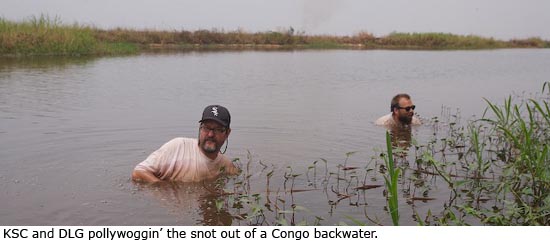
MPC-2006-011
Congo River, Malebo Pool, isolated pool on sand island, Kintele, Republic of Congo.
-04.161°, 015.356°
12 August 2006; KSC & DLG!
Two dead mutelas, found at the shore of an isolated pool, between sites 5 and 6.
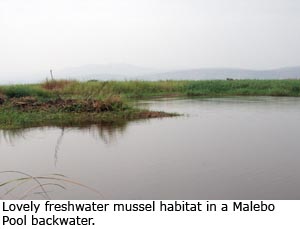 MPC-2006-015 MPC-2006-015
Congo River, Malebo Pool, backwater channel on sandy island, Republic of Congo.
-04.156°, 015.419°
15 August 2006; KSC & DLG!
Another back-water on a different sandy island. Lots of [soft-mud], but some mussels were also found in firmer substrate. "Honey-hole" in channel below sandy bank, with some flow.
Same species plus Aspatharia pfeifferiana. |
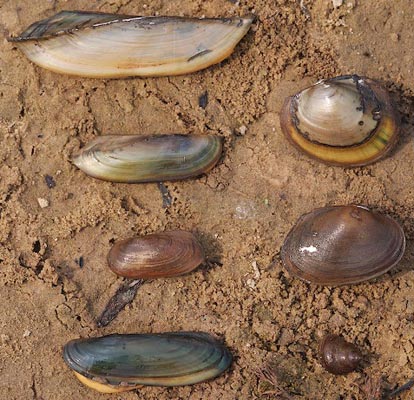
Species found in Malebo Pool: Chelidonopsis hirundo, Mutela legumen, Aspatharia pfeifferiana, M. "rostrata", Coelatura rotula, C. gabonensis and an unidentified snail.
Photograph by Oliver Lucanus.
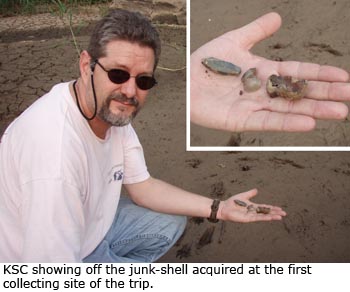 MPC-2006-001 MPC-2006-001
Congo River, Les Rapides, a few hundred meters above Site 7, below Brazzaville, Republic of Congo.
27 July 2006; KSC & DLG!
Coelatura rotula and Mutela "rostrata" from some little mud patty along the shore — in the grass. And some snails. All dead, but Mutela with guts.
In the fresh mud, with lots of "trails" and bird tracks. Are birds eating the land-locked mussels? |
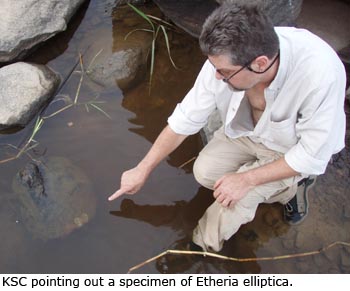 MPC-2006-007 MPC-2006-007
Congo River, Les Rapides, at mouth of the Djoué, below Brazzaville, Republic of Congo.
-04.312°, 015.230°
1 & 11 August 2006; KSC & DLG!
At the confluence of the Djoué at the Rapids in Brazzaville there is a large point of bedrock and boulders. We collected from the area of the left bank of the Djoué. Found dead Etheria shells; some cementing to rocks, others loose. All dead. These dead Etheria were attached to permanent rocks, so the live ones must be nearby...
Also some live, tiny prosobranchs attached to large cobbles. And dead Corbicula sp.
Melanie found a live Coelatura gabonensis in the adjacent sandy shore.
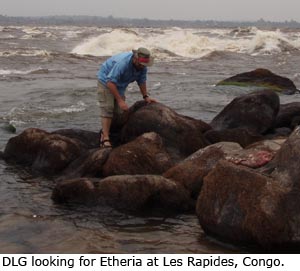 Returned 11 August; one Etheria and two junk-shell snails (discarded). Returned 11 August; one Etheria and two junk-shell snails (discarded).
The habitat at Les Rapides at the mouth the Djoué is an amazing torrent. The water level rose significantly over the course of our visits. Click here to see a video of the flow. |
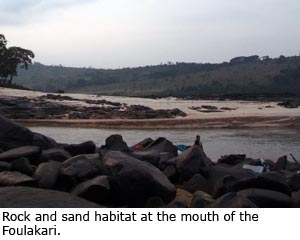 MPC-2006-008 MPC-2006-008
Congo River, at and near the mouth of the Foulakari, Republic of Congo.
-04.584°, 014.987°
3-4 August 2006; KSC, DLG & Stiassny et al.!
Our camp below les Chutes du la Foulakari was a barren wasteland for mollusks. We managed a mere handful.
The habitat was swift water with a bizarrely surging and shifting current. Presumably, downstream, the Congo narrows significantly, causing much of the water back upstream. The substrate was bedrock and boulders of sandstone and sand — lots of sand. The shoreline as far as we could see was steep, and the water got deep quickly.
The Fish Folks went upstream a few clicks and came back with a few freshwater gastropods.
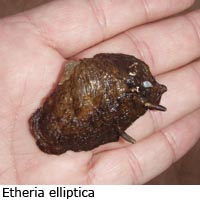 A fisherman brought us a couple Etheria, which he promptly crushed in his hands and threw back to the water. Kevin retrieved one. That fisherman reported that when the water level is lower, the mussels are easier to find. A fisherman brought us a couple Etheria, which he promptly crushed in his hands and threw back to the water. Kevin retrieved one. That fisherman reported that when the water level is lower, the mussels are easier to find.
Also found two crabs and Kevin got a dead Achatina. |
|